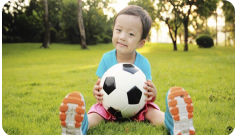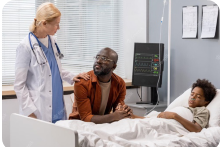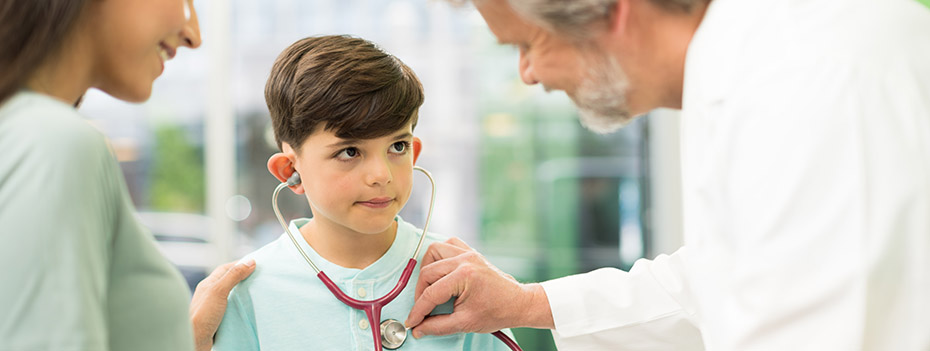After angiography procedure
Cardio-respiratory monitoring: After your child is transferred to the ward, he or she will undergo cardio-respiratory monitoring for continuous monitoring of vital signs. The purpose of cardio-respiratory monitoring is to continuously check blood oxygen, control the child’s heart rate at any moment, and control blood pressure every 15 minutes to an hour first and then every hour through the bedside monitoring device. Pay close attention to never disconnect the connections without coordinating with your babysitter!
child nutrition
Due to the use of sedatives to calm the child during angiography, your child may be confused and sleepy for a few hours after being transferred to the ward. Do not start feeding until your child gets fully awake, and after the nurse’s approval, start feeding your baby with breast milk or warm liquids such as tea, juice, and then soup, and continue with the child’s ordinary diet if tolerated and no nausea.
Location of angiography
The entry point of the angiography catheter is a tiny hole in the groin on one side or sometimes on both sides, which is covered with a pressure dressing. Sometimes it is possible to place a sandbag on the angiography site for up to 6 hours. Avoid opening the bandage and bending the leg from the thigh for at least 8 hours. Do not move the sandbag and keep the child’s foot still and motionless.

Physical examination
The pulse, color, and temperature of the lower limbs of the child will be checked at regular intervals by your nurse.
If you notice bleeding from the dressing site or feel cold or numb in the toes, inform your child’s nurse immediately.

Urination
After angiography, it is normal to feel difficulty urinating due to local anesthesia in the groin. Using a warm compress on the bladder will help a lot. If the color of urine changes to red or darker, inform the nurse as soon as possible.
Mobility
After 8 hours, your child can walk carefully and with help. At first, sit the child on the edge of the bed for 5 minutes and hang his or her legs, then slowly walk around the bed. If you feel dizzy and weak, return the child to the bed and inform the nurse. In case of severe pain in the lower abdomen and groin area, be sure to inform your nurse.
allergy
The appearance of fever and small red lesions in the child’s body within 24 hours after angiography is possible. It is a sign of the body’s reaction to the substances injected during angiography. If you develop a fever or small red lesions, discuss this with your nurse and doctor.
Dressing and wound site
The morning after the angiography, you can remove the bandage from the angiography site, and it is normal to observe a brief bruise and blood clot at the puncture site. In case of increased bruising or bleeding or unbearable pain at the angiography site, be sure to inform the nurse.
After discharge
Most patients can be discharged from the hospital 24 to 48 hours after angiography. If you need to continue treatment or surgery, you may stay hospitalized until the day of the operation. The day after angiography, your child can take a shower. Do not remove the fiber from the angiography site and avoid removing blood clots at the angiography hole site.
Bleeding
Check the angiography site daily for bruising, swelling, and pain. In case of bleeding from the angiography site at home, lay the child down and hold the puncture site with your fingers for about 15 minutes until the bleeding stops.
Medicine
Your child’s nurse will teach you exactly how to take the prescribed medicines and take the medicines according to the instructions.
Physical activity
To improve the mood and keep the body healthy, if the doctor decides, your child can continue sports activities after discharge. Avoid doing heavy work and putting pressure on the groin for 3 days after discharge. Limit heavy lifting, cycling, stair climbing, and prolonged sitting for a few days.

Follow up
If you need to continue the treatment or perform surgery as the next step of the treatment, all the training including the visit of the surgeon, how to get an appointment and the necessary preparations before the operation will be given to you at the time of discharge. You will be informed of the date of the next visit to the doctor for a repeat visit and an echo before discharge. You will also be given the means of communication with the department of congenital heart diseases and the doctor and nurse. If you need to continue treatment and your child’s treatment process is long, you can ask the medical team to introduce you to similar families so that you can use their experiences to better adapt to your child’s condition.

It is recommended to involve all family members to know about the condition of the child’s illness, the medicines taken, and necessary care; so that they can cooperate with the medical team if necessary.
After discharge, if you need dental procedures or other surgeries, be sure to inform your doctor about the condition of the child and the medications you are taking.
Always bring the child’s documents, including echocardiogram, case summary, list of medications, and educational sheets, when visiting any doctor.
Health, nutrition, and growth
Explain the child’s recovery and health status to him/her and help to resume daily activities and lead a normal life by strengthening the child’s self-confidence.
After performing angiography and closing the hole in the heart, the child’s weight will return to normal. continue the normal diet after discharge. Include fruits, vegetables, and nutrients in your child’s meals. Change meals to more frequent and smaller meals for better tolerance of the child. It is necessary to use high-calorie and high-protein foods to gain weight and improve your child’s growth. If necessary, ask your nurse for advice with a pediatric nutritionist.
After angiography, in case of complete recovery and removal of heart defects, your child’s frequent colds and respiratory symptoms related to heart disease will disappear. In case of respiratory infections, see the relevant doctor. Maintaining oral and dental hygiene is essential to prevent secondary infections. Familiarize your child with the correct way to brush your teeth and encourage them to follow it.
After the angiography and your child’s recovery, the child’s sleeping position will be normal, and note that the time of medication should be coordinated with the child’s waking time to avoid interrupting the sleep time.





